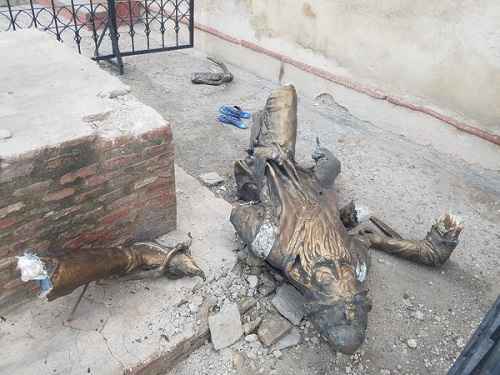As expected, the Taliban's takeover of Afghanistan has emboldened radicals in Pakistan with Tehreek-e-Labbaik Pakistan (TLP) Islamists destroying a nine-feet statue of Sikh ruler Maharaja Ranjit Singh on horseback at the Lahore Fort on Tuesday.
The video of TLP worker named Rizwan breaking the arm of the statue and dismantling the bust from the horse while chanting inflammatory slogans has now gone viral on social media.
It is not for the first time though that the nine-feet statue at the Mai Jinda's Haveli near the grave of Maharaja Ranjit Singh in Lahore Fort, also known as the Shahi Qila, has been broken.
In 2019, a few months after the statue was unveiled at the Lahore Fort on June 27 on the Sikh emperor's 180th death anniversary, two men vandalised the figure made of cold bronze. On another instance, in December 2020, another radical Islamist belonging to a religious group had broken the arm of the statue.
"Vandalism in Lahore of the statue of Maharaja Ranjit Singh Ji, the great unifier of India, has to be strongly condemned. This act which attempts to erase the shared history of the subcontinent shows how extremist ideologies feel emboldened in our volatile neighbourhood," tweeted Union Minister Hardeep Singh Puri.
Vandalism in Lahore of the statue of Maharaja Ranjit Singh Ji, the great unifier of India, has to be strongly condemned. This act which attempts to erase the shared history of the subcontinent shows how extremist ideologies feel emboldened in our volatile neighbourhood. pic.twitter.com/aI2wN3QGbe
— Hardeep Singh Puri (@HardeepSPuri) August 17, 2021
The Pakistani authorities, in a face-saving measure, said that the Punjab Police has arrested the TLP activist.
Lahore fort is located in north-western corner of the walled city. After the fall of the Mughal dynasty in Punjab, in the 18th century, the Sikhs occupied the Fort. It was enlisted among the World Heritage Sites in 1981 by UNESCO and transferred from the Archaeology Department Punjab to the Walled City of Lahore Authority in 2014.
It was here in the Sheesh Mahal, or the Palace of Mirrors, where Maharaja Ranjit Singh – popularly called Sher-e-Punjab – had passed away in June of 1839.
The life-size statue is first of its kind in Pakistan and was sculpted by artists from the National College of Arts and Lahore's Naqsh School of Arts under the guidance of Fakir Khana museum.
"Three inscriptions in brass have also been installed in English, Urdu and Gurmukhi depicting the life of the Maharaja. In the sculpture, the Maharaja is sitting on his favourite Arabic horse that was named ‘Kahar Bahar’, which was a gift by Dost Muhammad Khan, the founder of the Barakzai dynasty and prominent rulers of Afghanistan during the First Anglo-Afghan War," says UK-based writer, historian and filmmaker Bobby Singh Bansal who funded the project through Sikh Foundation.
Also Read: The Afghanistan Situation: How India can Discomfit Pakistan Even Now




















